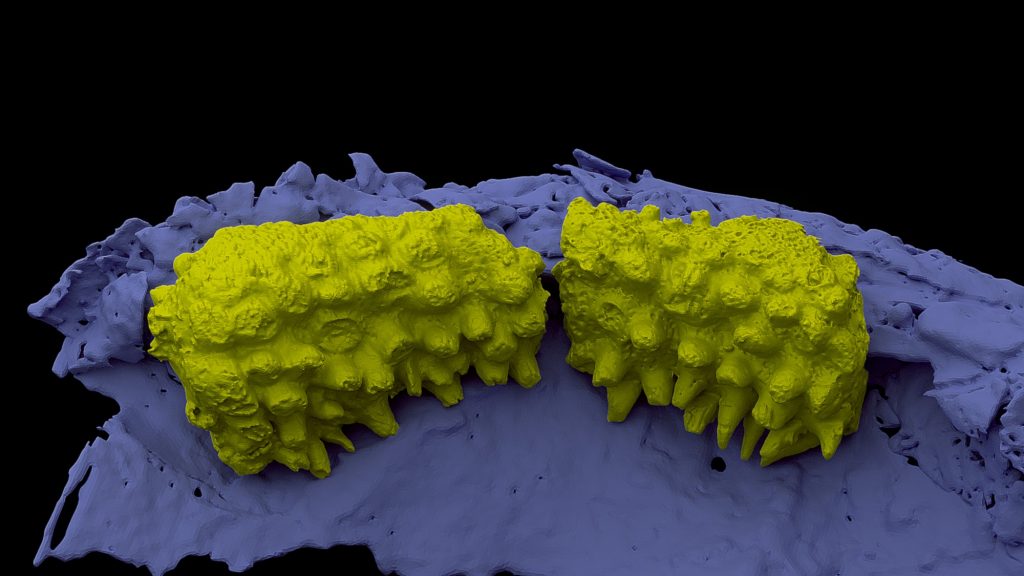 In the two extant jawed vertebrate groups, bony fish (and their descendants the land animals) and sharks, new teeth usually develop on the inner side of the old ones. Sharks have no bones and their teeth do not attach to the cartilaginous jaws, whereas in bony fish and land animals, the teeth are always attached to jaw bones. This diversity raises many questions about the origin of teeth. Until now, researchers have focused on fossils of a group of armoured fish, the arthrodires, the only stem jawed vertebrates in which teeth were known. They struggled to understand how they could have evolved into the teeth of modern vertebrates, as arthrodire teeth are so different in position and mode of tooth addition.
In the two extant jawed vertebrate groups, bony fish (and their descendants the land animals) and sharks, new teeth usually develop on the inner side of the old ones. Sharks have no bones and their teeth do not attach to the cartilaginous jaws, whereas in bony fish and land animals, the teeth are always attached to jaw bones. This diversity raises many questions about the origin of teeth. Until now, researchers have focused on fossils of a group of armoured fish, the arthrodires, the only stem jawed vertebrates in which teeth were known. They struggled to understand how they could have evolved into the teeth of modern vertebrates, as arthrodire teeth are so different in position and mode of tooth addition.
A team of scientists from the Charles University, Uppsala University, the European synchrotron ESRF in Grenoble, Natural History Museum in London, and the National Museum in Prague (Valéria Vaškaninová as a lead author) turned to the acanthothoracids, an early fish group closely related to the common ancestor of jawed vertebrates. The very finest of them come from the Prague Basin, but due to their fragility they have never been investigated in detail. The researchers used synchrotron microtomography at the European synchrotron, the world’s brightest X-ray source, which allowed them to visualise the internal structure of the fossils in 3D, including unexpected well-preserved dentitions. Follow-up scans at higher resolution visualized the growth pattern and perfectly preserved cell spaces inside the dentine.
Like arthrodires, the acanthothoracid dentitions are attached to bones. This indicates that bony fish and land animals retain the ancestral condition, whereas sharks are specialized. In other ways, acanthothoracid dentitions are fundamentally different from those of arthrodires. Like sharks, bony fish and land animals, acanthothoracids only added new teeth on the inside. Even though acanthothoracids are among the most primitive of all jawed vertebrates, their teeth are far more like modern ones than arthrodire dentitions. Their jawbones resemble those of bony fish and seem to be directly ancestral to our own.
Vaškaninová V., Chen D., Tafforeau P., Johanson Z., Ekrt B., Blom, H., Ahlberg P.E. (2020): Marginal dentition and multiple dermal jawbones as the ancestral condition of jawed vertebrates. Science 369, 211-216. (DOI)
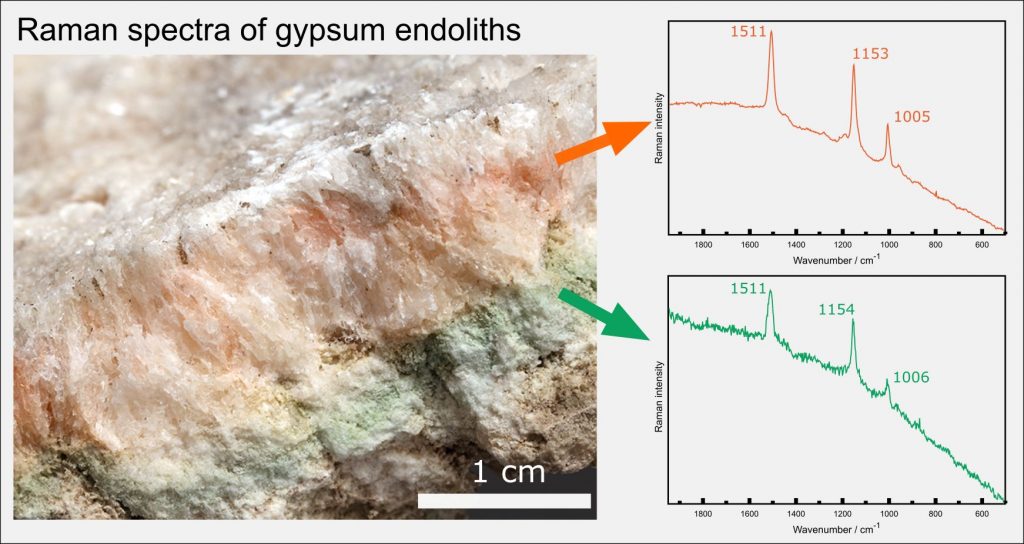









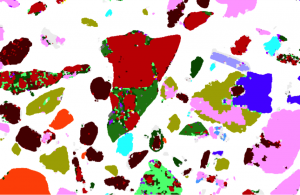 Automated mineralogy has been used to quantitatively determine the contaminant partitioning in the soil particulates originating from heavily polluted mining/smelting sites. This method provides faster data acquisition, the full integration of the quantitative EDS data and better detection limits for the elements of interest. AutoSEM was found to be a useful tool for the determination of the modal phase distribution and element partitioning in the metal(loid)-bearing (As, Cu, Pb, Zn) soil particulates and will definitely find more applications in environmental soil sciences in the future.
Automated mineralogy has been used to quantitatively determine the contaminant partitioning in the soil particulates originating from heavily polluted mining/smelting sites. This method provides faster data acquisition, the full integration of the quantitative EDS data and better detection limits for the elements of interest. AutoSEM was found to be a useful tool for the determination of the modal phase distribution and element partitioning in the metal(loid)-bearing (As, Cu, Pb, Zn) soil particulates and will definitely find more applications in environmental soil sciences in the future. In the two extant jawed vertebrate groups, bony fish (and their descendants the land animals) and sharks, new teeth usually develop on the inner side of the old ones. Sharks have no bones and their teeth do not attach to the cartilaginous jaws, whereas in bony fish and land animals, the teeth are always attached to jaw bones. This diversity raises many questions about the origin of teeth. Until now, researchers have focused on fossils of a group of armoured fish, the arthrodires, the only stem jawed vertebrates in which teeth were known. They struggled to understand how they could have evolved into the teeth of modern vertebrates, as arthrodire teeth are so different in position and mode of tooth addition.
In the two extant jawed vertebrate groups, bony fish (and their descendants the land animals) and sharks, new teeth usually develop on the inner side of the old ones. Sharks have no bones and their teeth do not attach to the cartilaginous jaws, whereas in bony fish and land animals, the teeth are always attached to jaw bones. This diversity raises many questions about the origin of teeth. Until now, researchers have focused on fossils of a group of armoured fish, the arthrodires, the only stem jawed vertebrates in which teeth were known. They struggled to understand how they could have evolved into the teeth of modern vertebrates, as arthrodire teeth are so different in position and mode of tooth addition.
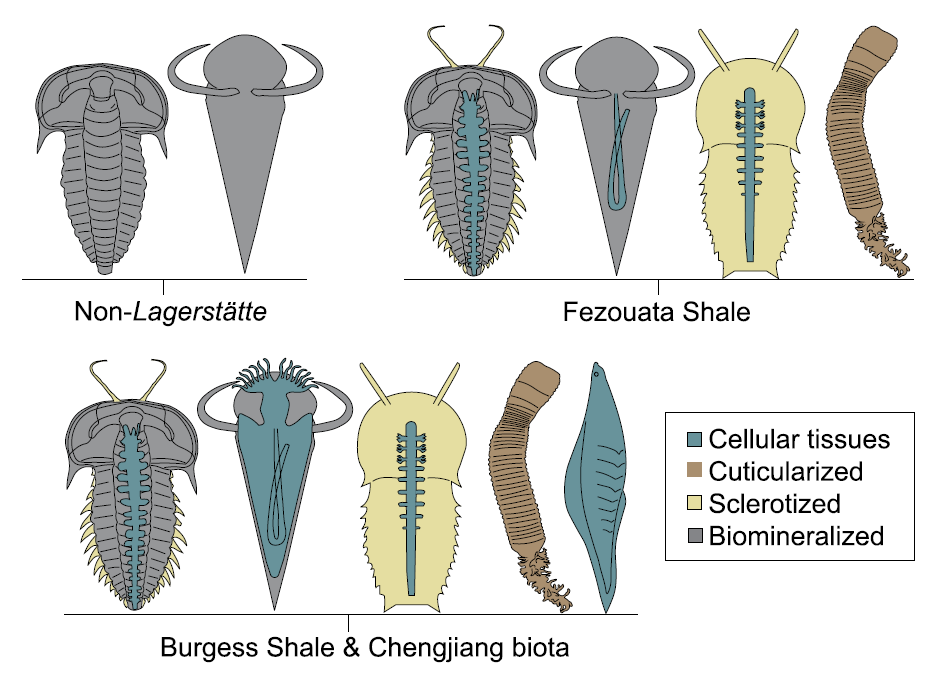 Exceptionally preserved fossils provide deep insight into early animal evolution. For example, the step by step evolution of morphological innovations that ultimately led to the origin of many recent animals was achieved using information from such exceptionally preserved fossils. Each of these sites with exceptional preservation – so-called Lagerstätten – is, however, a subject of specific fossilization bias. This means that at different fossil sites different information is lost during the fossilization process. To understand such information loss is especially important once we want to compare fossils from different sites and infer some general trends. Without knowing fossilization biases, we may end-up comparing apples and oranges. A new study by Saleh et al. (Lukáš Laibl as a co-author) tried to understand such biases. It compared three well known lower Paleozoic Lagerstätten – the Burgess Shale (ca. 505 million years old, Canada), the Chengjiang Biota (ca. 530 million years old, China) and the Fezouata Shale (ca. 479-478 million years old, Morocco). Interestingly, the Fezouata Shale is different from both Burgess and Changjiang. In Fezouata Shale, the soft parts of animals are most commonly associated with partially mineralized and sclerotized tissues. The digestive tract is, for example, preserved mostly in fossils with hard biomineralized exoskeletons (such as in trilobites and echinoderms). For the same reason, the entire soft animals are not preserved in Fezouata Shale. Indeed, most of the animals from Fezouata Shale were either biomineralized (trilobites, echinoderms, gastropods, brachiopods), sclerotized (many types of arthropods) or have had at least external cuticle (various “worms”). On the other hand, Burgess and Changjiang commonly preserve entirely soft animals and also show a higher diversity of different tissue types in particular fossil species. So to sum up, the answer to the question in the title is – yes, but with caution. We have to differentiate between fossilization absence and real absence. Many animals could have lived in the Fezouata Shale environment but were nor preserved because of the nature of the fossilization process. This is likely the case for early chordates that were entirely soft-bodied. On the other hand, the absence of penis worms (priapulids) in the Fezouata Shale is most probably a real aspect of the fauna, since these cuticle-bearing animals would “survive” the fossilization process.
Exceptionally preserved fossils provide deep insight into early animal evolution. For example, the step by step evolution of morphological innovations that ultimately led to the origin of many recent animals was achieved using information from such exceptionally preserved fossils. Each of these sites with exceptional preservation – so-called Lagerstätten – is, however, a subject of specific fossilization bias. This means that at different fossil sites different information is lost during the fossilization process. To understand such information loss is especially important once we want to compare fossils from different sites and infer some general trends. Without knowing fossilization biases, we may end-up comparing apples and oranges. A new study by Saleh et al. (Lukáš Laibl as a co-author) tried to understand such biases. It compared three well known lower Paleozoic Lagerstätten – the Burgess Shale (ca. 505 million years old, Canada), the Chengjiang Biota (ca. 530 million years old, China) and the Fezouata Shale (ca. 479-478 million years old, Morocco). Interestingly, the Fezouata Shale is different from both Burgess and Changjiang. In Fezouata Shale, the soft parts of animals are most commonly associated with partially mineralized and sclerotized tissues. The digestive tract is, for example, preserved mostly in fossils with hard biomineralized exoskeletons (such as in trilobites and echinoderms). For the same reason, the entire soft animals are not preserved in Fezouata Shale. Indeed, most of the animals from Fezouata Shale were either biomineralized (trilobites, echinoderms, gastropods, brachiopods), sclerotized (many types of arthropods) or have had at least external cuticle (various “worms”). On the other hand, Burgess and Changjiang commonly preserve entirely soft animals and also show a higher diversity of different tissue types in particular fossil species. So to sum up, the answer to the question in the title is – yes, but with caution. We have to differentiate between fossilization absence and real absence. Many animals could have lived in the Fezouata Shale environment but were nor preserved because of the nature of the fossilization process. This is likely the case for early chordates that were entirely soft-bodied. On the other hand, the absence of penis worms (priapulids) in the Fezouata Shale is most probably a real aspect of the fauna, since these cuticle-bearing animals would “survive” the fossilization process.
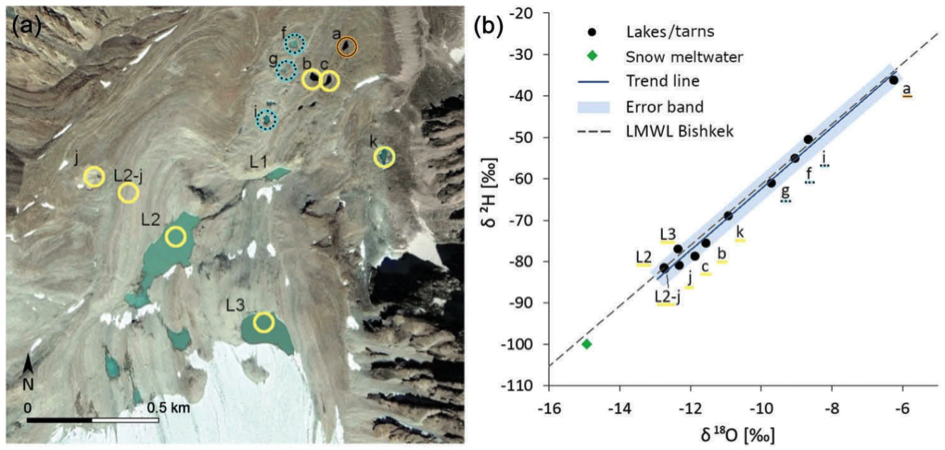 In this study, we characterized glacial meltwater flow through a proglacial area with a focus on proglacial lakes and their hydrological regime and connection to a stream. The studied lakes showed a distinct development throughout an ablation season. For example at Lake 2, the mean daily water-level fluctuation amplitude increased from 0.07 (June) to 0.18 m (August), then dropped to 0.07 m (September). Glacial meltwater flows through the lakes and further downstream through a rock glacier rather fast (0.085 m/s), however only a small portion of water (< 1%) is routed efficiently. The complexity of the site‘s drainage system is supported by varying isotopic composition of water in the tarns situated on the rock glacier, with Tarn a) being the most enriched and Tarn c) the most depleted in heavy isotopes. The results from this study site provide new insights into the complexity of a drainage system connecting a glacier and a stream. Further research of the tarns and subsurface water routing could bring new knowledge about the temperature-related degradation and internal changes of the rock glacier. Considered significant global water storage and influencing hydrological conditions of watersheds, these landforms will certainly draw more attention in near future.
In this study, we characterized glacial meltwater flow through a proglacial area with a focus on proglacial lakes and their hydrological regime and connection to a stream. The studied lakes showed a distinct development throughout an ablation season. For example at Lake 2, the mean daily water-level fluctuation amplitude increased from 0.07 (June) to 0.18 m (August), then dropped to 0.07 m (September). Glacial meltwater flows through the lakes and further downstream through a rock glacier rather fast (0.085 m/s), however only a small portion of water (< 1%) is routed efficiently. The complexity of the site‘s drainage system is supported by varying isotopic composition of water in the tarns situated on the rock glacier, with Tarn a) being the most enriched and Tarn c) the most depleted in heavy isotopes. The results from this study site provide new insights into the complexity of a drainage system connecting a glacier and a stream. Further research of the tarns and subsurface water routing could bring new knowledge about the temperature-related degradation and internal changes of the rock glacier. Considered significant global water storage and influencing hydrological conditions of watersheds, these landforms will certainly draw more attention in near future.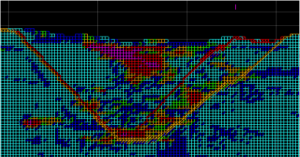 Cristian Quinones, geologist-geostatistician from Chile will stop in Prague during his lecture tour at European universities and will give a two-day workshop on “Practices for Mineral Resources Statement and Study Cases”. The course will take place on 26th and 27th March 2020 (9-17h) in Ložiskové sbírky room, Faculty of Science, Charles University, Albertov 6 building. Topics covered include International Codes, Audits, QAQC, Geological Models, Exploratory Data Analyses. For registration, see with one of the organizers, Dr. Jiří Zachariáš (
Cristian Quinones, geologist-geostatistician from Chile will stop in Prague during his lecture tour at European universities and will give a two-day workshop on “Practices for Mineral Resources Statement and Study Cases”. The course will take place on 26th and 27th March 2020 (9-17h) in Ložiskové sbírky room, Faculty of Science, Charles University, Albertov 6 building. Topics covered include International Codes, Audits, QAQC, Geological Models, Exploratory Data Analyses. For registration, see with one of the organizers, Dr. Jiří Zachariáš (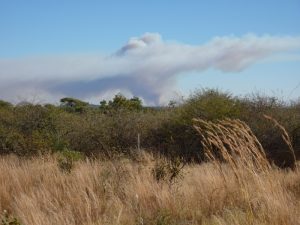 Mercury distribution in topsoils and vegetation samples and temperature-dependent Hg mobilization simulating wildfires have been investigated near a Cu smelter in semi-arid Namibia. The thermo-desorption experiments performed on the representative Hg-rich topsoils indicated that >91% of the Hg was released at ~340°C, which corresponds to the predominant grassland-fire conditions. Despite the installation of a sulfuric acid plant in the smelter in 2015 and a calculated drop in the estimated Hg emissions (from 1301 ± 457 kg/y for the period 2004-2015 to 67 ± 5 kg/y after 2015), the Hg legacy pool in the smelter surroundings will contribute to wildfire-driven Hg emissions until its complete burn-out. Using the Hg spatial distribution data in the area (184 km2), the estimates indicate that up to 303 kg and 1.3 kg can be remobilized from the topsoils and vegetation, respectively.
Mercury distribution in topsoils and vegetation samples and temperature-dependent Hg mobilization simulating wildfires have been investigated near a Cu smelter in semi-arid Namibia. The thermo-desorption experiments performed on the representative Hg-rich topsoils indicated that >91% of the Hg was released at ~340°C, which corresponds to the predominant grassland-fire conditions. Despite the installation of a sulfuric acid plant in the smelter in 2015 and a calculated drop in the estimated Hg emissions (from 1301 ± 457 kg/y for the period 2004-2015 to 67 ± 5 kg/y after 2015), the Hg legacy pool in the smelter surroundings will contribute to wildfire-driven Hg emissions until its complete burn-out. Using the Hg spatial distribution data in the area (184 km2), the estimates indicate that up to 303 kg and 1.3 kg can be remobilized from the topsoils and vegetation, respectively.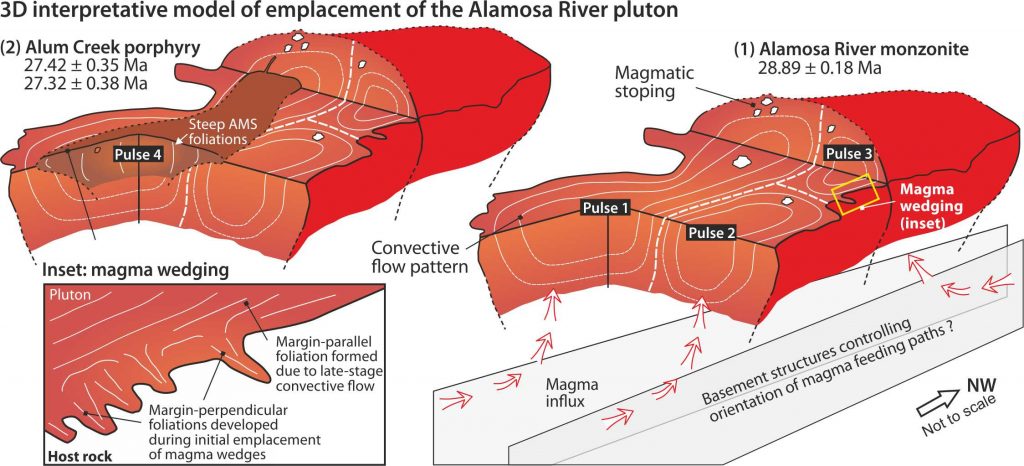 Volcanic calderas are hazardous phenomena associated with cataclysmic eruptions that threaten surrounding nature, human society, and may also affect climate on a global scale. Active calderas are thus carefully monitored, however the underlying magma plumbing systems that store eruptible melt and feed ignimbrite eruptions are still poorly understood. In this paper, we have focused on the extinct Platoro caldera complex that erupted six large ignimbrite sheets between 30.2 Ma and 28.8 Ma in the Rocky Mountains (Colorado), and is associated with voluminous postcaldera intrusions. Using a multiparametric study (field mapping, petrography, radiometric dating, rock magnetism and anisotropy of magnetic susceptibility) of the Alamosa River pluton (29.0–27.3 Ma), we discovered an interesting behavior of magmatic activity that occurred after the main collapse episode. It has been documented that shallow-level magmatic systems of collapsed calderas remain active for another few millions of year, and produce multipulsed intrusions and complex dike swarms. Moreover, such intrusion are further distinguished as resurgent and postresurgent. The former induces ground deformation in form of uplifted domes, whereas the latter has no effect at the Earth´s surface.
Volcanic calderas are hazardous phenomena associated with cataclysmic eruptions that threaten surrounding nature, human society, and may also affect climate on a global scale. Active calderas are thus carefully monitored, however the underlying magma plumbing systems that store eruptible melt and feed ignimbrite eruptions are still poorly understood. In this paper, we have focused on the extinct Platoro caldera complex that erupted six large ignimbrite sheets between 30.2 Ma and 28.8 Ma in the Rocky Mountains (Colorado), and is associated with voluminous postcaldera intrusions. Using a multiparametric study (field mapping, petrography, radiometric dating, rock magnetism and anisotropy of magnetic susceptibility) of the Alamosa River pluton (29.0–27.3 Ma), we discovered an interesting behavior of magmatic activity that occurred after the main collapse episode. It has been documented that shallow-level magmatic systems of collapsed calderas remain active for another few millions of year, and produce multipulsed intrusions and complex dike swarms. Moreover, such intrusion are further distinguished as resurgent and postresurgent. The former induces ground deformation in form of uplifted domes, whereas the latter has no effect at the Earth´s surface.